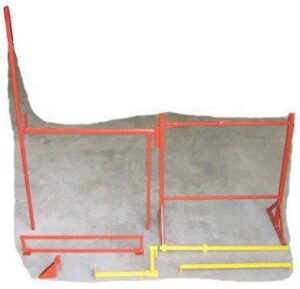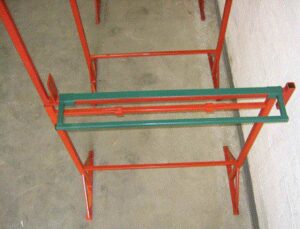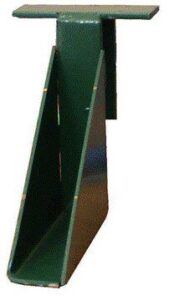Case Overview
In this Court of Appeal case ([2025] EWCA Civ 374), Safestand successfully appealed a High Court ruling that their designs were invalid.
At the end of 2023, HHJ Hacon ruled on a case in the High Court between Safestand Ltd and Weston Homes PLC ([2023] EWHC 3250 (Pat)).
In the first instance proceedings, Safestand had brought proceedings against Weston alleging patent and registered design infringement. In respect of the design infringement, Weston counterclaimed for invalidity, arguing that the registered designs did not depict a single article, lacked clarity, and did not have individual character.
HHJ Hacon found that the patents were infringed by Weston, but that the registered designs were irreparably invalid as they did not represent single designs.
The parties settled their dispute before the start of appeal proceedings, however Safestand appealed the finding that their designs were invalid. Weston Homes did not appear, and written submissions were filed on behalf of the Comptroller for the UKIPO.
A Single Design must be registered; registration of multiple designs can lead to irreparable invalidity
Section 1(2) of the Registered Designs Act 1949 (RDA) defines a design as meaning “the appearance of the whole or a part of a product.”
Anyone seeking a declaration of invalidity on the grounds that a Registered Design is not for a single design may begin invalidity proceedings under Section 11ZA(1)(a) of the RDA; which states that a design may be declared invalid if it fails to meet the requirements set out in Section 1(2) of the Act.
The right of a proprietor to amend a Registered Design where the registrar intends to declare the design in valid is set out in Section 11ZD of the RDA, but applies only to declarations of invalidity under section 11ZA(1)(b) or (c), (1A), (3) or (4).
This means that a finding of invalidity under Section 11ZA(1)(a) by the registrar cannot be repaired by amending the designs post-grant.
The Registered Designs at Issue
The designs at issue were Re-Registered UK Designs 90002293490001, 90003121450004, and 90003121450005, relating to builder’s trestles, which are low level scaffolding installations. All of the designs had seven views, each of which were colour photographs. Relevant illustrations from RRD ‘0001 are shown below.



[Illustrations 1, 5, and 7 of Design 90002293490001, UKIPO Design Registry]
The trestles themselves comprised several parts, some of which were shown in part views as part of the Registered Design. In particular, considering RRD ‘0001, the following parts were shown in the first illustration:
- A red frame forming the upper part of the trestle
- A red frame with triangular feet forming the lower part of the trestle
- Yellow upright bars
- Yellow handrails
- A yellow ladder bracket
- A first red bracket for holding wooden boards
- A second red bracket for holding wooden boards
In the first instance proceedings, Safestand ran into trouble with subsequent views which showed the red brackets (from the first illustration) in green. As it is established case law that differently coloured versions of the same product constitute different designs, HHJ Hacon found at [232] that “there is a difference between a single design with contrasting but unspecified colours… and a design shown in colour with alternative colours. That latter is not a single design…”. The RRD was thus considered invalid on this basis at first instance.
In overturning this finding, the Court of Appeal considered that the judge had not properly considered the modularity of the design. Arnold LJ found the judgement in T-25/23, Orgatrex GmbH & Co KG v EUIPO persuasive. This case, relating to floor markings, considered whether the views in a Registered Community Design were for a single product. In this CJEU judgement, it was held that:
- Inconsistencies or contradictions between the filed views may lead to the conclusion that the representation shows different products.
- A design cannot relate to a single design if the views are “insurmountably contradictory.”
- However, unicity of design may be established despite “minor discrepancies”
Applying this guidance, Arnold LJ found that the Safestand designs were not insurmountably contradictory in view of the modular nature of the product, although it was accepted by Safestand that the “net effect of the images is that the product includes at least one red and one green … bracket.”
In the case of RRD ‘0005, it was found that the failure to include a green bracket in the view showing the assembled product, but rather two red brackets was a minor discrepancy within the meaning of the judgement in Orgatrex, and that this design was therefore also valid.
It therefore appears that minor inconsistencies between views may not be fatal for Registered Design, however, as above, the scope of the Registered Design may be affected by such inconsistencies. Therefore we would always recommend seeking professional advice before filing Registered Design applications for the best chance securing valid, enforceable rights. Safestand could have avoided this, for example, by filing black and white line drawings or representations which disclaimed the colours (although this would have potentially brought in additional prior art).
Lack of Clarity on Clarity as a Ground of Invalidity for Registered Designs
One interesting question which arose in this case was whether lack of clarity is a valid ground for invalidity. In his judgement Arnold LJ acknowledged that there were reasonable arguments on both sides: Safestand argued that there was no basis in the legislation for challenging the validity of a registered design based on clarity (no such provision exists in Section 11ZA of the Registered Designs Act (RDA) 1949), and that the practice here should be analogous to that for patents. In a written submission, the Comptroller argued that lack of clarity should amount to a failure to comply with Section 1(2), since “a lack of clarity is just as important after registration as before.”
Ironically, the Court of Appeal did not provide clarity on clarity as a ground of invalidity, since they disagreed with the first instance judge, HHJ Hacon’s finding that it was “not possible to tell with reasonable certainty from the illustrations whether the design is of a single article”, with the result that the lack of clarity resulted in the registration being for multiple designs and therefore invalid. By finding that the Registered Designs were for a single design, the need to answer this question was avoided.
In his judgement, Arnold LJ wrote that the question of whether clarity was a ground of invalidity in its own right is “an important argument which should only be decided if it is necessary to do so and with the benefit of full adversarial argument.”
Conclusions
Overall, the judgement demonstrates the need for care in registering designs in general, and especially designs for modular products or products making use of colour coding. Particular attention needs to be paid pre-filing to make sure that the drawings show what the Applicant actually wants to protect as it may not be possible to fix this later.
Although the question of whether lack of clarity is a ground for invalidity in its own right was not decided by the court, it was held that a design which contains minor inconsistencies between views may still be valid.
If you have any questions on Registered Designs, please get in touch with the authors, or your usual contact at Boult.






